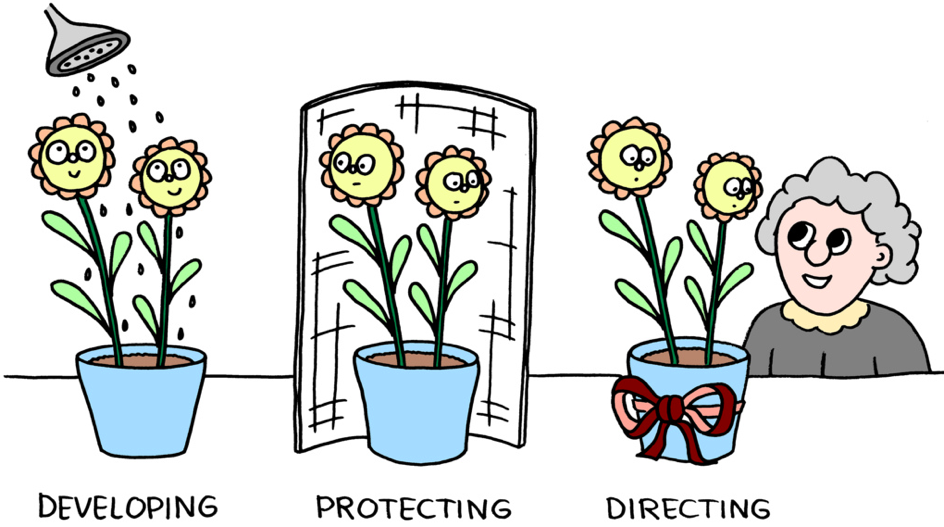“Many have forgotten how to work independently” Human Resources Manager magazine . The magazine sees reasons in the fact that many employees have forgotten how to work independently due to classic management practice or hardly have the chance to learn it. Every decision, for example when to take vacation, was made for them by the manager, so that at first it was difficult for them to actually work in a self-organized manner, to take on responsibility and to show commitment. They also underline the thesis of my article on agile HR management – more than Scrum that more and more companies are now starting to transfer agile methods such as Scrum from IT to other areas of the company. Personnel development is not spared either.
Personnel development in an agile context
Provides an approach Dr. Ralf Graesslerwho states the following: “What we are currently doing is not moving a battleship (= company) from A to B and then resting again. The digital transformation is not a change in the sense of a change management process. Rather, it requires that Breaking up existing thought patterns and structures towards a delicate adaptability. This will make it possible to deal with the complexity of the environment and the inherent constant willingness to change. We change in order to be able to change further. “.
Furthermore, Dr. Gräßler has numerous practical examples such as the following: “At a large transport company with over 50,000 employees worldwide, employees can define, document and compare their skills and goals themselves in order to” match “development opportunities using a global job platform. The positions are offered and maintained by the specialist departments themselves. What does HR do? A lot: empowering employees and managers to move in these new structures. It is not trivial. On the contrary, the tasks of HR in agile structures cannot be overrated – HR needs courage, methodological competence and knowledge of human nature in order to pursue agile personnel development and to do justice to the task complexes below. ”
This shows that personnel development in an agile context means understanding the changes in the digital world and reacting to them, as well as making a real contribution to value. Dr. So Gräßler provides a first introduction to personnel development in an agile context and also finds out for himself that many questions have not yet been adequately clarified and that it is therefore necessary to try them out.
Agile personnel development still raises many questions
Provides another approach Dr. Frank Edelkraut , which states that agile still raises many questions in the form of:
- Structure and process organization,
- Performance evaluation,
- Bonus systems,
- Co-determination,
- and much more.
In terms of agile personnel development, he is of the same opinion as Dr Gräßler, namely that many questions have not yet been adequately clarified. He sees the problem that the logic of agile work does not fit the current structures and the self-image of current organizations. He predicts long negotiations and conflicts. In addition to cultural change, that means the second task is to bring all stakeholders to one table.
Back to the actual topic: agile personnel development. So it changes somehow and the full scope in the agile context has not yet been sufficiently clarified, but the first approaches and guidelines have definitely been established with which company can start the first experiments and pilot projects. This is how Dr. Edelkraut said that personnel development and talent management will change as follows:
- More individual, more diverse, more digital, more social and more interactive,
- more autonomous by the employees,
- with new roles and areas of responsibility,
- as well as integration into day-to-day operations.
Summary
The two approaches of Dr. Gräßler and Dr. Edelkraut penetrate very well into the core of agile personnel development and also show the influences of digital transformation on it. Certainly it is not possible to summarize all ideas that deal with the topic, but I think that with the two authors at least a first idea can be given in the direction of this topic. In the end, I think that a picture by Jürgen Appelo visualizes the topic very well. Agile personnel development is actually not much more than developing people, protecting them and letting them go in the right direction. Kind of like a potted plant.

Dr. Frank Edelkraut: http://de.slideshare.net/fredel00/hr-in-agilen-umgebungen
Human Resources Manager: https://www.humanresourcesmanager.de/ressorts/artikel/viele-haben-verlernt-eigenverponslich-zu-arbeiten
Appelo, J. (2010). Management 3.0: Leading Agile Developers, Developing Agile Leaders . Boston: Addison-Wesley Professional.



